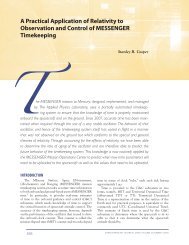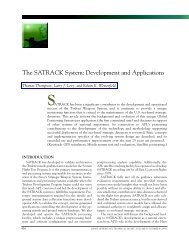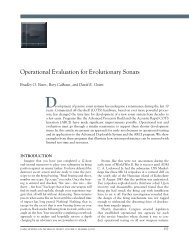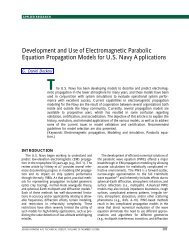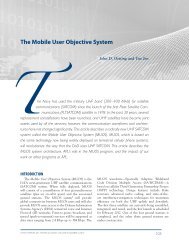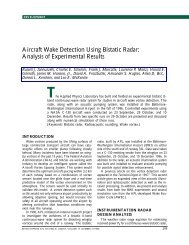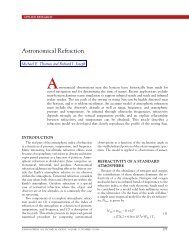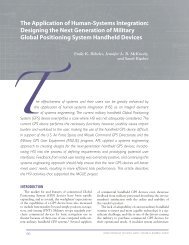Modern Electronic Packaging Technology - Johns Hopkins APL ...
Modern Electronic Packaging Technology - Johns Hopkins APL ...
Modern Electronic Packaging Technology - Johns Hopkins APL ...
You also want an ePaper? Increase the reach of your titles
YUMPU automatically turns print PDFs into web optimized ePapers that Google loves.
(a)<br />
(b)<br />
0<br />
(c)<br />
Gold-plated<br />
bond ribbon<br />
0<br />
Solder balls,<br />
eutectic or solid core<br />
(solid core shown)<br />
1 2 3 4 5<br />
Centimeters<br />
1 2<br />
Centimeters<br />
Flexible circuit tape<br />
with or without adhesive<br />
(shown with adhesive)<br />
Elastomer pad<br />
Silicon die<br />
the high yields possible with BGAs and CSPs,<br />
many companies choose to forgo the X-ray inspection<br />
of solder joints and, instead, monitor the assembly process<br />
closely.<br />
Heat dissipation is usually not a problem for BGAs.<br />
For example, Olin has developed a high-performance<br />
256-ball BGA (27 27 mm) package that, when dissipating<br />
1 W, can be as little as 12.5°C over ambient<br />
temperatures with natural convection. 15<br />
The reliability of these new surface-mounted area<br />
arrays has been tested and found to be satisfactory for<br />
commercial applications; however, their history of use<br />
is short—too short to build confidence for space and<br />
military applications. Efforts are now under way to<br />
Soldermask or<br />
coverlayer<br />
Low-modulus<br />
encapsulant<br />
Figure 5. Several views and implementations of array packages. (a) Top and bottom views<br />
of a ball-grid array. (b) Bottom view of chip-scale packages (CSPs). (c) Cross-sectional<br />
view of a CSP. (Photograph courtesy of Tessera, Inc.)<br />
MODERN ELECTRONIC PACKAGING TECHNOLOGY<br />
establish reliability limits for highreliability<br />
applications. 16 Today, the<br />
use of BGA and CSP packages in<br />
these applications is limited to situations<br />
where no other traditional<br />
package can meet the requirements.<br />
MULTICHIP MODULE<br />
PACKAGING<br />
Sometimes it is advantageous to<br />
package several devices in one<br />
package, forming a multichip module<br />
(MCM). By combining individual<br />
devices and components into a<br />
single package, significant miniaturization<br />
is achieved over individually<br />
packaged devices mounted on<br />
a substrate. In doing so, multichip<br />
packaging muddles the distinction<br />
between device packaging and circuit<br />
boards.<br />
The combination of Level 1 and<br />
2 packaging into an MCM offers a<br />
significant advantage of low-volume,<br />
high-density packaging commonly<br />
found in the aerospace and<br />
military markets. In low volume, an<br />
MCM is an economical alternative<br />
to a custom-designed integrated circuit,<br />
since much of the miniaturization<br />
is achieved without the high<br />
initial cost of integrated circuit design.<br />
Many highly integrated devices<br />
began as an MCM before subsequent<br />
production volume justified a<br />
commitment to redesign as a single<br />
silicon circuit. The disadvantages to<br />
MCM technology over individually<br />
packaged devices are significantly<br />
higher costs of the assembly and<br />
decreased yield caused by using in-<br />
completely tested silicon die. Verification of device<br />
performance without packaging (i.e., the “knowngood-die”<br />
problem) has received considerable attention<br />
in the electronics industry, but little progress has been<br />
made in the ability to do so. The critical issues are cost<br />
and system yield, for without the high probability of a<br />
working device, assembly yields are low (Fig. 6), and<br />
the test and rework costs increase exponentially.<br />
Multichip packaging substrates range widely in<br />
cost and interconnect density. Those MCMs with<br />
printed circuit board substrates have the lowest cost<br />
and lowest interconnect density; those with singlecrystal<br />
silicon substrates have the highest cost and<br />
highest interconnect density. Alumina and other<br />
JOHNS HOPKINS <strong>APL</strong> TECHNICAL DIGEST, VOLUME 20, NUMBER 1 (1999) 29<br />
3




